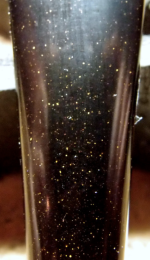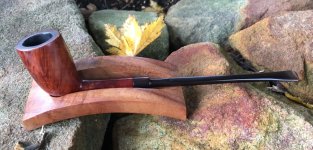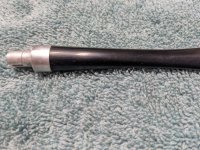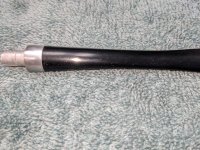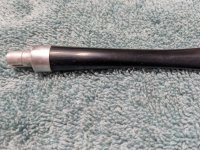I'm puzzled by an issue with an old Dr. Grabow stem from earlier this year. Hoping someone can offer insight before I start work on the next one.
The issue is that no matter how much oxidation I removed (and no matter the method used) the oxidation kept presenting itself, and was not apparently diminishing. After several soaks, lots of sanding, and many different treatments found online, the problem remained.
With very fine sanding I was able to smoothen the stem enough to see the oxidation as hundreds (thousands?) of tiny flecks along the stem, like lots of tiny pits filled with the orange crud. Sanding these flecks would remove them, but only served to reveal new pits with more oxidation, and the cycle would repeat.
I thought if I sanded deep enough I'd eventually get below the layer of material that was infected with the pitting, but there seemed to be no end to it. Eventually I just went to a finer micromesh pad and polished over the top of the visible oxidation, which served to pull it off without opening new pits beneath it. A cosmetic fix, but oxidation still remains all throughout the stem at deeper levels.
Just found this thread today:
The explanations of the oxidation process offered here are helpful, particularly the description of vulcanite material as a collection of compressed cells. But there's no mention of how deep oxidation can go, or if it can permeate completely throughout stem.
All information I've found online suggests that oxidation affects the surface layer of a stem, and can be removed by sanding down past that layer to reveal "fresh" unaffected material. This doesn't match my experience. It appears the entire thickness/substsance of the stem is riddled with pockets of oxidation than can only be masked over.
My questions:
1. Can oxidation indeed run all the way through vulcanite stem material, given enough time? I always figured once deep enough to avoid air contact it would stop...meaning it's possible to sand the oxidation from the surface of the stem and everything beneath that layer is clean.
2. If it can run all throughout, and sanding will only reveal more of it deeper down, is it harmful to do as I've done and polish over the surface area, leaving untouched oxidation deeper in the stem material?
3. How do you handle something like this? Is there a way to completely draw out all oxidation that's premeated a stem? Or are you doomed only to have effect on the surface layer...
Hope this makes sense.
The issue is that no matter how much oxidation I removed (and no matter the method used) the oxidation kept presenting itself, and was not apparently diminishing. After several soaks, lots of sanding, and many different treatments found online, the problem remained.
With very fine sanding I was able to smoothen the stem enough to see the oxidation as hundreds (thousands?) of tiny flecks along the stem, like lots of tiny pits filled with the orange crud. Sanding these flecks would remove them, but only served to reveal new pits with more oxidation, and the cycle would repeat.
I thought if I sanded deep enough I'd eventually get below the layer of material that was infected with the pitting, but there seemed to be no end to it. Eventually I just went to a finer micromesh pad and polished over the top of the visible oxidation, which served to pull it off without opening new pits beneath it. A cosmetic fix, but oxidation still remains all throughout the stem at deeper levels.
Just found this thread today:
My Experience with Lbepen Deoxidizer [with pics] :: Pipe Repair and Maintenance
Would this stuff remove logos? all of these products would. I usually make sure the logo has some silicone grease on the logo. Sometimes I use tape and silicone grease. Vaseline isn’t bad, but you need a grease that is thick. Plumbers grease is good as well.
pipesmagazine.com
The explanations of the oxidation process offered here are helpful, particularly the description of vulcanite material as a collection of compressed cells. But there's no mention of how deep oxidation can go, or if it can permeate completely throughout stem.
All information I've found online suggests that oxidation affects the surface layer of a stem, and can be removed by sanding down past that layer to reveal "fresh" unaffected material. This doesn't match my experience. It appears the entire thickness/substsance of the stem is riddled with pockets of oxidation than can only be masked over.
My questions:
1. Can oxidation indeed run all the way through vulcanite stem material, given enough time? I always figured once deep enough to avoid air contact it would stop...meaning it's possible to sand the oxidation from the surface of the stem and everything beneath that layer is clean.
2. If it can run all throughout, and sanding will only reveal more of it deeper down, is it harmful to do as I've done and polish over the surface area, leaving untouched oxidation deeper in the stem material?
3. How do you handle something like this? Is there a way to completely draw out all oxidation that's premeated a stem? Or are you doomed only to have effect on the surface layer...
Hope this makes sense.
Last edited:






